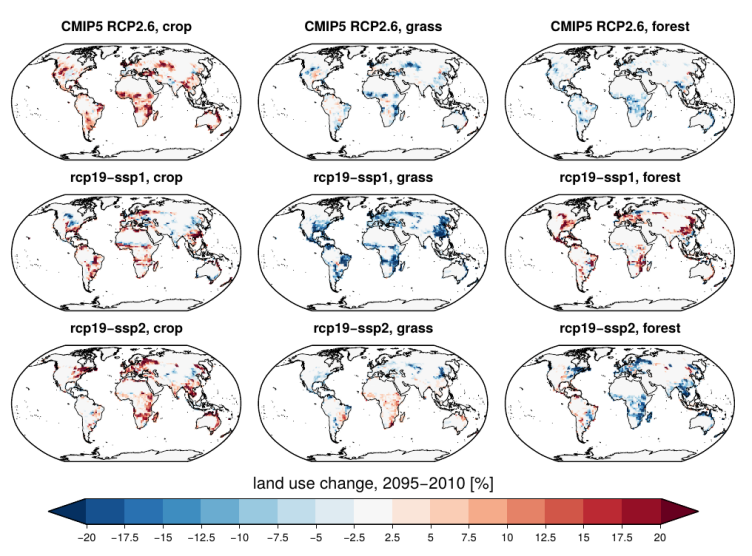HAPPI-LAND
Half a degree Additional warming, Prognosis and Projected Impacts (external pageHAPPIcall_made) – Land use scenario experiment
Coordination
Contact: Benoit P. Guillod, Annette L. Hirsch, and Sonia I. Seneviratne (ETH Zurich)
Project overview

Limiting global warming to 1.5 or 2 degrees, as agreed by 196 nations at the 21st Conference of the Parties (COP21), will require a serious commitment to emissions reduction that could involve major land use change (LUC) by the end of the century [UNFCCC, 2015], for instance associated with bioenergy use, crop production, and afforestation [Popp et al., 2016]. However, scenarios developed to assess potential pathways to low global warming targets only consider the biogeochemical effects of LUC [van Vuuren et al., 2014] while the associated biophysical effects on climate [Bonan 2008; Seneviratne et al., 2010; Davin et al., 2014; Hirsch et al., 2017; Thiery et al., 2017] are not accounted for.
This project aims to examine the biophysical effects of LUC associated with the global warming targets at 1.5°C or 2°C. We use two new scenarios consistent with a 1.5°C global warming derived from an Integrated Assessment Model [Stehfest et al., 2014] to drive LUC simulations for several Earth system models (ESMs). The applied LUC scenarios are consistent with both global warming targets, but represent different societal pathways for climate mitigation and adaptation. The overall setup builds upon the HAPPI simulation protocol [Mitchell et al., 2017], which aims to evaluate how the impacts of climate change vary between the 1.5˚C and 2˚C global warming targets.
Current participants of HAPPI-LAND include 4 ESM groups (CESM, HadAM3P, MIROC and MPI-ESM).
Project Team
- Experimental Design: Benoit P. Guillod, Annette L. Hirsch, and Sonia I. Seneviratne (ETH Zurich, Switzerland), Victor Brovkin (MPI- Meteorology, Hamburg, Germany), and Detlef van Vuuren (PBL, Den Haag, The Netherlands)
- IMAGE land use scenarios: Jonathan C. Doelman, Elke Stehfest, and Detlef van Vuuren (PBL, Den Haag, Netherlands)
- CESM: Benoit P. Guillod, Annette L. Hirsch, Urs Beyerle, and Sonia I. Seneviratne (ETH Zurich, Switzerland)
- MPI-ESM: Lena Boysen, and Victor Brokin (MPI- Meteorology, Hamburg, Germany)
- MIROC: Hideo Shiogama (NIES, Tokyo, Japan), Tomoko Nitta (University Tokyo, Japan), and Hyungjun Kim (University Tokyo, Japan)
- HadAM3P: Dann Mitchell (Bristol University, UK), Sarah Sparrow (CPDN, Oxford, UK), and Mamun Rashid (CPDN, Oxford, UK)
- HAPPI Coordination: Dann Mitchell (Bristol University, UK), and Mamun Rashid (CPDN, Oxford, UK)
- Data Portal: Daithi Stone (LBNL, USA)
References
Bonan, G.B., (2008) Forests and climate change: forcing, feedbacks, and the climate benefit of forests. Science 320, 1444–1449, doi:10.1126/science.1155121.
Davin, E.L., S.I. Seneviratne, P. Ciais, A. Olioso, and T. Wang (2014), Preferential cooling of hot extremes from cropland albedo management. PNAS, 111(27),external pagedoi: 10.1073/pnas.1317323111call_made.
Hirsch, A. L., M. Wilhelm, E.L. Davin, W. Thiery, and S.I. Seneviratne (2017), Can Climate-Effective Land Management Reduce Regional Warming? J. Geophys. Res. Atmos., 122, doi:external page10.1002/2016JD026125call_made.
Mitchell, D.; and Coauthors (2017), Half a degree additional warming, prognosis and projected impacts (HAPPI): background and experimental design. Geosci. Model Dev.,10, 571-583, doi:10.5194/gmd-10-571-2017.
Popp, A., and Coauthors, (2016), Land-use futures in the shared socio-economic pathways. Global Environmental Change, 1–15, doi:10.1016/j.gloenvcha.2016.10.002.
Seneviratne, S.I., T. Corti, E.L. Davin, M. Hirschi, E.B. Jaeger, I. Lehner, B. Orlowsky, and A.J. Teuling (2010), Investigating soil moisture-climate interactions in a changing climate: A review. Earth-Science Reviews, 99, 3-4, 125-161, doi:10.1016/j.earscirev.2010.02.004.
Stehfest, E., and Coauthors (2014), Integrated Assessment of Global Environmental Change with IMAGE 3.0. Model description 839 and policy applications, The Hague.
Thiery, W., E.L. Davin, D.M. Lawrence, A.L. Hirsch, M. Hauser, and S. I. Seneviratne (2017), Present-day irrigation mitigates heat extremes. J. Geophys. Res. Atmos., 122, doi:external page10.1002/2016JD025740call_made.
United Nations Framework Convention on Climate Change (2015), Adoption of the Paris Agreement. Report No. FCCC/CP/2015/L.9/Rev.1. [Available at http://unfccc.int/resource/docs/2015/cop21/eng/l09r01.pdf.]
van Vuuren, D. P., and Coauthors, 2014: A new scenario framework for Climate Change Research: scenario matrix architecture. Climatic Change, 122, 373–386, doi:10.1007/s10584-013-0906-1.
